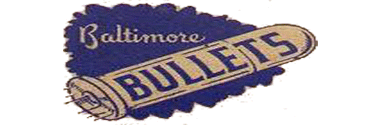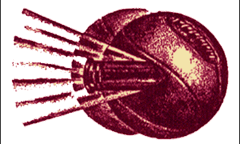The Baltimore Bullets started out in the American Basketball League. The name's origin has several meanings, including a nearby armory where the team practiced and their brand of sneakers called Bata Bullets. The Bullets coached by Buddy Jeannette, a guard who was also the team's top player was high successful in the ABL, which was more of a loose confederation of professional basketball teams than a major professional sports league.
1947/48: The Baltimore Bullets accepted in an invitation to join the Basketball Association of America. The league which was attempting to become the first major professional basketball league had four teams fold following its first season and were looking for an eighth member. After losing to the Washington Capitols 63-55 in their first game on November 12th. The Baltimore Bullets earned their first BAA win in their home opener one day later, beating the Boston Celtics 85-74 to start a nine game winning streak. The Bullets would not be able to maintain their early success as their winning streak was immediately followed up by a five game losing streak. However, in the Western Division they remained in the playoff chase all season, as all four teams finished within one game of first place. The Bullets would have five players average more than ten points per game, as Player-Coach Buddy Jeanette was a second team all-star, while Paul Hoffman was the BAA's top rookie performer. The Bullets would end the season with a record of 28-20, in a three way tie for second place. The Bullets would play in a round robin for the last two playoff slots in the West, beating the Chicago Stags 75-72 for second place. The Bullets would see the Stags again in the semifinals, after beating the New York Knickerbockers in a best of three series with the home team taking each game. Facing the Stags the Bullets would win two straight to advance to the BAA Finals. In the BAA Finals the Baltimore Bullets faced the reigning champion Philadelphia Warriors. After suffering a 71-60 loss in the opener, the Bullets squeezed out a 66-63 win in Game 2 to even the series. The Bullets would defend their home court in the next two games, winning by scored of 72-70 and 78-75 to take a 3-1 series lead. Following a 91-82 loss in Philadelphia in Game 5, the Bullets would crush the Warriors 88-73 to capture the BAA's second championship.
1948/49: Following a championship in their first BAA season, the Baltimore Bullets got off to a slow start, losing seven of their first ten games. The Basketball Association of America got a boost as four teams joined the league from the National Basketball League, increasing the level of competition. The Bullets who moved to the Eastern Division would finish the season with a record of 29-31, finishing in third place, which was good enough to slip into the postseason. In the playoffs the Bullets would face the New York Knickerbockers winning the opener at the Baltimore Coliseum 82-81. However, with the next two games in New York the Bullets would fall in three games.
1949/50: The NBL and BAA merge to become the National Basketball Association. The increased competition would make the league much stronger, but the Bullets continued to produce diminishing results posting a record of 25-43, which landed them in fifth place and left them one game out of a playoff spot. Paul Hoffman and Ed Sakowski each had solid seasons averaging more than 14 points per game, but the season was an overall disappointment.
1950/51: The Baltimore Bullets continued to struggle, as longtime player-coach retired as a player and then was fired as coach with the team off to a 14-23 start. Walt Budko would take over and the Bullets would not do much better, finishing the season with a record of 24-42 as they finished in fifth place and missed the playoff for the second straight season.
1951/52: The Baltimore Bullets continued to shoot blanks, as Fred Scolari and Chuck Reiser both failed as head coach, with the Bullets finishing in last place with a record of 20-46. Scolari did much better as a player, leading the team with 14.6 points per game, while Don Barksdale and Stan Miasek also had strong seasons, with double digit point per game averages.
1952/53: Chuck Reiser would be relieved of his coaching duties as the Bullets dropped their first three games. Under Clair Bee the Bullets would not do much better, winning just 16 games. However, in the Eastern Division their 16-54 record was good enough to slip into the postseason. In the playoffs the Bullets would be outmatched and over classed by the New York Knickerbockers who won back-to-back blowouts.
1953/54: While playing 20 games on neutral courts with the NBA looking to reach new fan bases the Baltimore Bullets who shot to the top in their first season in the league, continues to struggle at the bottom of the league, posting a terrible record of 16-56 which was the worst in the entire league. The Bullets would lose played on an opponent's home floor, while winning just four games on a neutral court.
1954/55: As the season began the Baltimore Bullets were deep in the red, and on the verge of folding. Ownership was running out of money and did not have enough money to pay for operating costs. On Thanksgiving Night the Bullets lost to the Fort Wayne Pistons 92-89 on the road. With the team out of money to pay for their hotel rooms and player meals a decision was made to cease operations at 3-11. The team barely had enough money to return to Baltimore, and had to make a choice of returning home or paying their hotel bills. The hotel manager tried to stop the team from checking out, but the players snuck out a back exit and into an awaiting limo. Upon arriving at the airport the Bullets quickly boarded the plane and closed the door without paying the driver.













